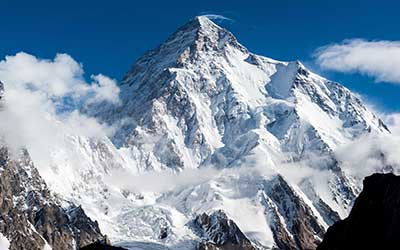Relevance: GS-3: Conservation, Environmental Pollution, and Degradation, Environmental Impact Assessment
Key phrases: Avalanches, sea-level rise, Technocentric model ,National Mission for Sustaining the Himalayan Ecosystem, National Action Plan on Climate Change, SECURE Himalayas Project, Cycle of erosion, Char Dham project, Early warning system,landscape based development approach,water-based energy
Why in News ?
- The recent studies on Himalayan glaciers, find out that glaciers across the Himalayas are melting at an extraordinary rate, vast ice sheets shrank 10 times faster in the past 40 years than during the previous seven centuries.
About Himalayas
- Himalayas are the highest and the youngest fold mountain ranges of the world.
- Since their geological structure is young, thus the whole region very vulnerable for earthquakes.
- It covers an area about 16.2% of the country's total geographical area.
- Responsible for fulfilling water needs to a large part of the Indian subcontinent.
- Many rivers considered holy like the Ganga and Yamuna flow from the Himalayas.
Research Findings
- Avalanches, flooding, and other effects of the accelerating loss of ice imperil residents in India, Nepal, and Bhutan and threaten to disrupt agriculture for hundreds of millions of people across South Asia.
- Since water from melting glaciers contributes to sea-level rise, glacial ice loss in the Himalayas also adds to the threat of inundation and related problems faced by coastal communities around the world.
- Ice loss in the Himalayas is very rapid, the new study found. The researchers didn’t pinpoint a reason but noted that regional climate factors, such as shifts in the South Asian monsoon, may play a role.
- In addition to floods, rising sea levels can cause soil erosion and jeopardize the structural integrity of roads and bridges as well as power plants and other critically important industrial facilities located in coastal areas.
- In coming decades, Mountain glaciers probably have been the most significant contributors to sea level rise.
- As the himalayan glaciers continue to shrink, the availability of water for irrigation and drinking water could drop steeply
- Mountain glaciers are expected to vanish completely in some regions by 2100.
National Action Plan on Climate Change:
There are 8 national missions forming the core of the NAPCC
- National Solar Mission
- National Mission for Enhanced Energy Efficiency
- National Mission on Sustainable Habitat
- National Water Mission
- National Mission for Sustaining the Himalayan Ecosystem
- National Mission for A Green India
- National Mission for Sustainable Agriculture
- National Mission on Strategic Knowledge for Climate Change
Government steps to protect Himalayan Ecosystem
1. National Mission for Sustaining the Himalayan Ecosystem
- Salient aspects of mission are:
- Formulation of appropriate policy measures and time-bound action programmes for sustainable development of Himalayan Ecology.
- Developing capacities at the national level and state level to continuously assess its health status.
- Continuous studying of the Himalayan glaciers and associated hydrological consequences and prediction and management of natural hazards.
2. SECURE Himalayas Project.
- Main features of project are:
- Secure people’s livelihood, restore, conserve and use sustainably the high range ecosystems of the Himalayas.
- Improving the enforcement to ensure the reduction in wildlife crime, protection of snow leopard and other endangered species and ensuring a secure livelihood to the people in the region.
- Protecting the people’s livelihood has taken topmost importance, they are the last preservers of their heterogeneous culture and local knowledge that has a global significance.
- Stringent monitoring and better enforcement measures to inhibit the illegal trade in medicinal and aromatic plants.
Concerns
- An technocentric model of development involving destruction of forests and damming of rivers, is an invitation to disasters.
- Region entering a phase of irreversible ecological degradation.
- Over usage of heavy machinery to flatten land for agriculture disturbs the natural cycle of erosion.
- In its 2020 report, the Supreme Court appointed-high-powered committee on the Char Dham project noted the massive slope cutting, unmindful of the irreversible loss it was causing to the fragile terrain.
- Hydroelectric projects development at lightning speed—Uttarakhand alone identified projects adding up to nearly 10,000 mw of power and plans for 70-odd projects, the ecological cost of power produced was underestimated, while the hydro-electric potential was overestimated
- Ignoring high seismicity causing fatal landslides and severe damage to life and livelihood underestimated.
- Unsustainable models of tourism including the inappropriate and dangerous construction, poorly designed roads and associated infrastructure, inadequate solid waste management, air pollution etc.
- Country lacks a sophisticated warning system for predicting landslides.
Way forward
- Need for landscape based development approach, considering whole Himalayan a single region, which should be an ecocentric based development strategy.
- Development should be based on the use of the region’s important resource for development and local livelihood security.
- Promoting sustainable Tourism in the Indian Himalayan Region, which can offers a valuable long-term solution to the whole ecosystem, as local livelihood relies heavily on the existence of a sound tourism industry.
- Strengthening skills and entrepreneurial opportunities to harnessing the immense potential of niche mountain products as well as address uncertainties, such as adverse impacts of climate change.
- The policy for water-based energy in the region needs to be carefully balanced, it policy should lay down mandatory ecological flow provisions and tough enforcement measures and penalties for ensuring that construction of the project does not harm the mountain stability or local water systems.
- Green measures like growing more trees that can hold the soil through roots and identifying areas of rock fall as well as cracks that indicate landslides are crucial too.
Mains Question:
Q. According to recent studies on Himalayan glaciers, it is found glaciers across the Himalayas are melting at an extraordinary rate and in many regions there will be no glaciers by 2100. In this context, discuss the issues related with Himalayan Ecology, and why despite many government efforts, the outcomes are not very encouraging. (15 marks)
Source: The Hindu BL









